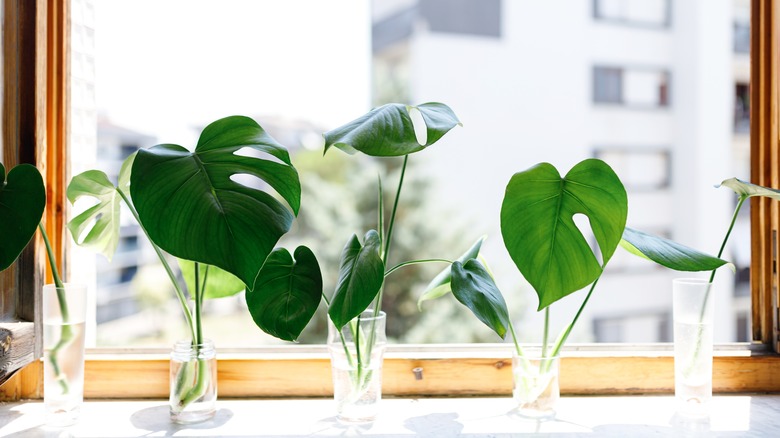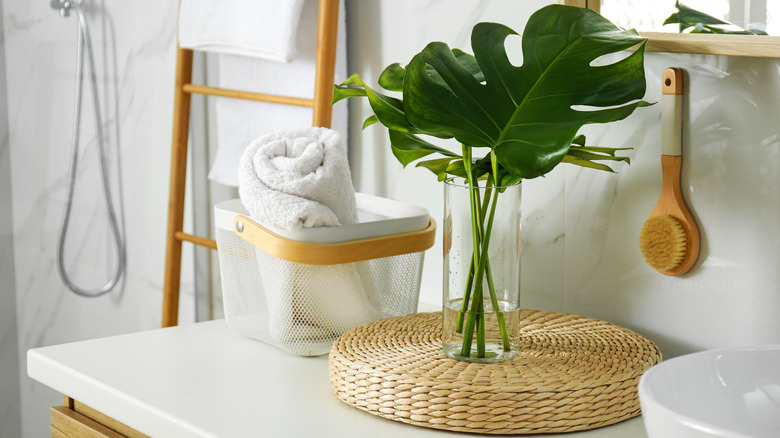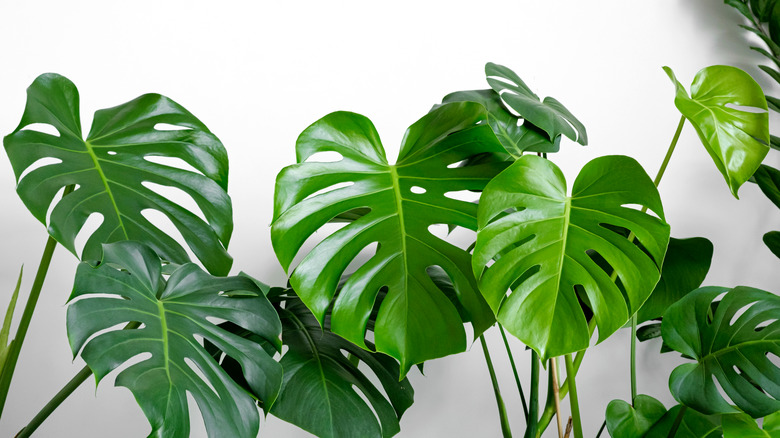Why Growing Monstera Plants With Hydroponics Works So Well
Monsteras are one of the showstoppers of the houseplant world. With glossy green leaves, dramatic fenestration, and the ability to grow up to 15 feet tall indoors, monstera deliciosas are a must-have for a plant lover's collection. The other benefit is that monsteras are easy to care for, requiring little maintenance and fuss for the plant to grow. That's what makes them a great candidate for hydroponics.
Water is often used as a propagation method to grow new roots and leaves. But leaving a plant in water verges into hydroponic territory. Hydroponics is the practice of growing plants in water without the need for soil. There is also a method called semi-hydroponics which uses an inorganic medium like LECA balls, coco coir, or Rockwool, and water to grow plants.
Because monsteras are highly adaptable plants, they're an ideal candidate for hydroponics. As long as the plant is getting the right amount of light and has proper hydroponic maintenance, monsteras can certainly grow and thrive in only water or LECA. However, it is important to note that hydroponic monsteras aren't likely to grow as large as ones grown in soil. But if you're growing cuttings or don't mind a slightly smaller plant, hydroponics is a great option.
Why choose hydroponics
In general, hydroponics has many benefits over traditional houseplant growing methods that use soil. Anyone who has houseplants knows the perils of pests and how they can potentially wreak havoc on the roots and leaves as well as simply be a nuisance. Many plant pests, such as fungus gnats, lay their eggs and live in soil, and unless you catch them early can get out of control. Removing the soil and growing plants in just water removes many potential pest problems.
Growing a monstera is also a great method to prevent overwatering and underwatering because the plant roots will soak up as much water as they need. The entire root system isn't submerged in water, allowing the roots and water to receive the necessary oxygen needed to survive. Root rot is also less of an issue with hydroponics. And because there are no fungi or bacteria in sterile water, plant infections are less of a possibility.
For those who like to use their houseplants as a decorative feature, hydroponics is also a great option. Growing monsteras in water mean you can grow them in a decorative vase. You can place them anywhere as long as they'll receive bright indirect light for the majority of the day. This means you can place them as accents around the room or as a centerpiece on a table.
How to grow a monstera in water
Growing a monstera in water is relatively easy. To start, you need a healthy cutting. Because water roots and soil roots are different, you shouldn't transfer a mature, rooted plant from soil into water. Instead, you'll want to take a cutting from the mature plant that has at least one leaf and cut below the node. You'll want to clean the cutting to remove any soil to ensure the water stays clean.
When it comes to the container, one made of glass is best. The transparency will allow you to check on the roots without having to remove the entire plant from the container. Glass also allows you to see any bacterial growth that may cause harm to the plant. Proper hydroponics comes down to the water. Tap water may have chemicals or minerals that pose a health risk to the monstera. It's best to use rainwater or filtered water for a clean growing medium.
Once you've put the monstera in water, place the vase in an area that will allow it to get bright indirect light for a full day. Both east- and west-facing windows receive sunlight throughout the day, with east-facing receiving more morning light and west-facing receiving more afternoon light. South-facing windows get full sun throughout the entire day. All three are great options for hydroponic monsteras.


